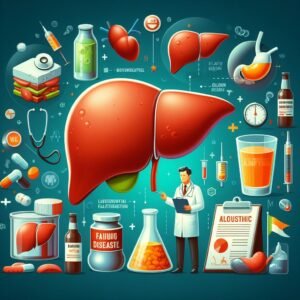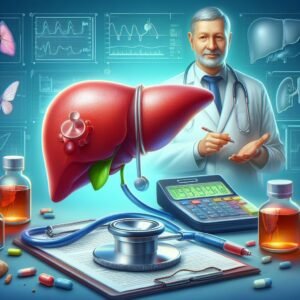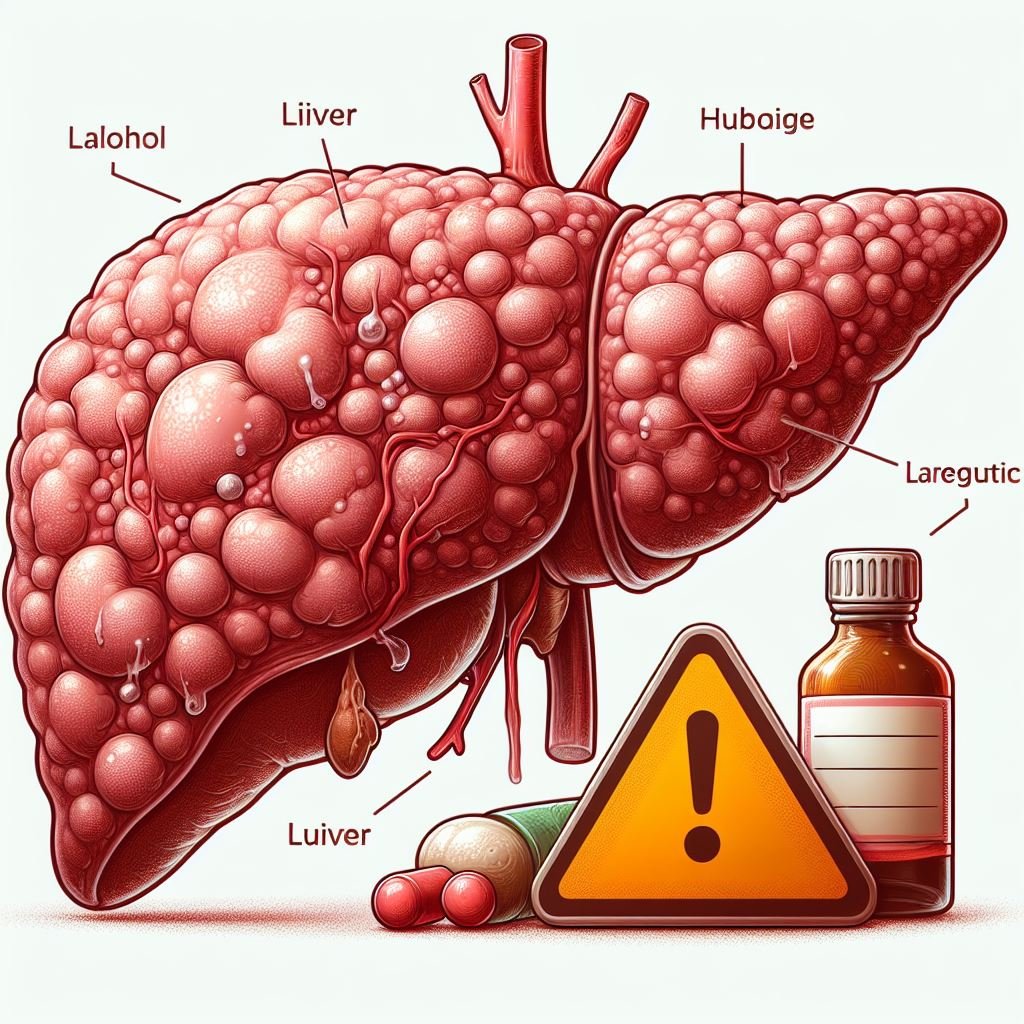Alcoholic Fatty Liver Disease: Understanding the Silent Threat
Introduction of Alcoholic Oily Liver:
Alcoholic Oily Liver Disorder (AFLD) addresses the fundamental and most dominating kind of liver mischief incited by constant alcohol use. It is depicted by an irrational assortment of fat inside liver cells, a condition known as steatosis, which happens when the liver’s capacity to use alcohol is overwhelmed.
This weakness prompts a disparity in lipid processing, making fat improvement in the liver. AFLD is commonly asymptomatic in its starting stages, making it a calm yet gigantic prosperity risk. Whenever left uncontrolled, it can progress to extra outrageous conditions like alcoholic hepatitis, fibrosis, and cirrhosis, which have serious prosperity ideas and can provoke liver frustration.
Given the unlimited usage of alcohol generally, AFLD is a huge general prosperity concern, featuring the meaning of early revelation, lifestyle changes, and public consideration regarding moderate its impact.
Pathophysiology

AFLD happens when the liver’s ability to use alcohol is overwhelmed, inciting an assortment of fat inside liver cells (hepatocytes). Routinely, the liver isolates alcohol into harmless substances through metabolic cycles. In any case, preposterous alcohol utilization upsets these cycles, provoking extended fat blend and reduced fat oxidation. This results in greasy oil collection inside hepatocytes, showing up as oily liver.
The primary mechanisms involved include:
Altered lipid metabolism:: Alcohol impacts mixtures and pathways drew in with lipid assimilation, propelling fat mix and testimony.
Oxidative stress: Alcohol processing produces responsive oxygen species (ROS), truly hurting oxidative tension and further liver cell.
Inflammation Consistent alcohol use prompts a searing response, intensifying liver mischief and adding to contamination development.
Risk factor of Alcoholic Oily Liver
A couple of bet factors work on the likelihood of making Alcoholic Oily Liver Disorder (AFLD), including the multifaceted design and complex nature of this condition:
Quantity and Duration of Alcohol Consumption: The primary bet factor for AFLD is the aggregate and repeat of alcohol affirmation. Significant and deferred drinking overwhelms the liver’s ability to deal with alcohol, inciting fat get-together. Continuous usage, even in moderate aggregates, can in like manner add to the improvement of AFLD over an extended time.
Genetics: Innate tendency expects a basic part in the lack of protection to AFLD. Certain genetic assortments can impact how capably the body utilizes alcohol and fixes liver damage, making a couple of individuals more leaned to making AFLD than others.
Gender: Women are overall more vulnerable to AFLD than men. This extended shortcoming is a result of differentiations in alcohol processing; women will by and large acclimatize more alcohol and get some margin to manage it, which achieves more unmistakable transparency of liver cells to alcohol’s hurtful effects.
Nutrition: Unfortunate dietary status, especially needs essential supplements and cell fortifications, can intensify liver mischief achieved by alcohol. Absence of sound food debilitates the liver’s ability to fix itself and regulate oxidative strain, growing the bet of AFLD.
Coexisting Liver Conditions: Individuals with other liver sicknesses, similar to hepatitis C, are at a higher bet of making AFLD. The presence of these conditions can strengthen the liver’s shortcoming to alcohol related mischief and accelerate the development of liver disorder.
Obesity and Metabolic Syndrome: Being overweight or having conditions like diabetes and raised cholesterol can deteriorate oily liver disease. The mix of these metabolic bet factors with alcohol usage by and large works on the likelihood of AFLD.
Age: More prepared adults may be at a higher bet in view of complete liver damage after a few time and lessened regenerative constraint of liver cells. Age-related metabolic changes can in like manner influence the new development and development of AFLD.
Understanding these bet factors is significant for recognizing individuals at higher bet for AFLD and executing preventive measures. General prosperity strategies should focus in on showing people these risks and raising lifestyle changes to reduce alcohol usage and work on all around liver prosperity.
Clinical Presentation

The clinical demonstration of Alcoholic Oily Liver Ailment (AFLD) can change, yet it is a large part of the time unassuming, particularly first and foremost stages. Various individuals with AFLD are asymptomatic and may not comprehend they have the condition until it is distinguished through routine clinical appraisals or testing for insignificant issues.
Regardless, when incidental effects do present, they can give huge bits of knowledge to the presence of the sickness.
Fatigue and Weakness: A regular and unclear incidental effect, exhaustion results from the liver’s diminished ability to do its not unforeseen metabolic jobs, provoking an overall vibe of drowsiness and deficiency.
Abdominal Discomfort or Pain: A couple of individuals could experience disquiet or a dull, pulsating irritation in the upper right quadrant of the mid-district, where the liver is found. This exacerbation is a direct result of liver intensification and bothering.
Hepatomegaly: Real evaluation by a clinical benefits provider could uncover an expanded liver (hepatomegaly). The liver could feel fragile to the touch, and this expanding is a direct result of the conglomeration of fat and the liver’s combustible response to alcohol.
Mild Jaundice: In additional created cases, jaundice can occur, portrayed by yellowing of the skin and eyes. Jaundice exhibits that the liver’s ability has been basically handicapped, affecting its ability to process and wipe bilirubin off of the blood.
Nausea and Vomiting: A couple of individuals could experience stomach related incidental effects, for instance, squeamishness and heaving, which can be connected with liver brokenness and the body’s response to unreasonable alcohol utilization.
Loss of Appetite and Weight Loss: Diminished hankering and inadvertent weight decrease can occur as the liver’s prosperity debilitates, affecting by and large and ingestion.
Confusion or Cognitive Impairment: In outrageous cases, where liver capacity is in a general sense split the difference, harms that the liver would consistently dispose of can foster in the course framework, conceivably provoking disorder or mental issues, a condition known as hepatic encephalopathy.
Since these secondary effects can be unclear and get over with various conditions, finding habitually requires a mix of clinical evaluation, research focus tests, and imaging survey. Recognizing AFLD early, especially in individuals with a foundation set apart by alcohol use, is central for thwarting sickness development and executing practical therapy frameworks.
Diagnosis
Diagnosing Alcoholic Oily Liver Contamination (AFLD) incorporates an extensive methodology that integrates a point by point clinical history, genuine evaluation, research focus tests, and imaging survey. These logical advances help with avowing the presence of AFLD, assess the level of liver damage, and block other likely purposes behind liver disease.
Medical History and Physical Examination:
History of Alcohol Use: A cautious history of alcohol use is critical. Patients are gotten some data about their drinking penchants, including the aggregate, repeat, and length of alcohol affirmation. Real specifying is principal for a definite finding.
Physical Examination: The clinical consideration provider plays out a genuine test to check for signs of liver contamination. This could consolidate contacting the midriff to recognize liver turn of events (hepatomegaly) and checking for jaundice or other genuine signs of liver brokenness.
Research office Tests:
Laboratory Tests:
Liver Function Tests (LFTs): These blood tests measure levels of liver proteins (ALT, AST), bilirubin, and various substances made by the liver. Raised levels of liver mixtures can show liver disturbance or damage.

Complete Blood Count (CBC): A CBC can help with perceiving pallor or various inconsistencies that may be connected with liver disease.
Serum Albumin and Coagulation Tests: These tests study the liver’s ability to convey proteins and thickening factors, giving comprehension into liver capacity.
Other Tests: Additional blood tests may be directed to block viral hepatitis, invulnerable framework liver diseases, and various conditions that can cause equivalent secondary effects.
Imaging Studies:
Ultrasound: This is a significant part of the time the primary imaging study performed. It can recognize the presence of fat in the liver, liver expansion, and other basic changes.
Computed Tomography (CT) Scan or Magnetic Resonance Imaging (MRI):These imaging strategies give more point by point viewpoints on the liver, helping with studying the level of fat storing up and block other liver pathologies.
Fibro Scan: This specific ultrasound-based advancement gauges liver robustness, which can show fibrosis (scarring) in the liver.
Liver Biopsy: on occasion, a liver biopsy may be recommended to insist the finding and assess the earnestness of liver mischief. During a biopsy, a little illustration of liver tissue is taken out and reviewed under an amplifying focal point. This can help with isolating AFLD from various types of liver infections and give information on the level of exacerbation and fibrosis.
Non-Invasive Markers: Emerging effortless tests and biomarkers are being made to study liver fat substance and fibrosis without the necessity for a biopsy. These tests, similar to serum biomarkers and undeniable level imaging techniques, offer less prominent decisions for finding and noticing.
By joining information from the patient’s arrangement of encounters, genuine appraisal, research office tests, and imaging survey, clinical consideration providers can exactly dissect AFLD and choose the best blueprint for treatment and the chiefs. Early end is critical for preventing the development of AFLD to extra outrageous liver contaminations and dealing with figuring out results.
Prognosis
The supposition for Alcoholic Oily Liver Sickness (AFLD) by and large depends upon a couple of factors, including the stage at which the disease is examined, the patient’s overall prosperity, and their ability to make and stay aware of lifestyle changes, particularly with respect to alcohol usage.
Early Diagnosis and Alcoholic Abstinence:
Reversible Condition: AFLD in its starting stages, generally called clear steatosis, is all around reversible. Expecting dissected early and the solitary stops finishing alcohol, the liver can recover, and fat collection can be diminished or discarded.
Improved Outcomes: Early intervention with complete alcohol patience, joined with a sound eating standard and ordinary action, essentially deals with liver capacity and by and large theory. Various individuals can achieve full recovery accepting that they adhere to these changes.
Continued Alcohol Consumption:
Disease Progression: In case alcohol usage continues, AFLD can progress to extra serious kinds of liver contamination, similar to alcoholic hepatitis, fibrosis, and cirrhosis. These conditions incorporate irritation, liver cell hurt, and scarring, which can incite enduring liver mischief and debilitated liver capacity.
Increased Morbidity and Mortality: Significant level liver ailment conveys higher risks of snares, including liver dissatisfaction, passage hypertension, and hepatocellular carcinoma (liver illness). The perception turns out to be less lucky as the contamination propels, with extended grimness and demise rates.
Other Health Factors:
Coexisting Conditions: The presence of other clinical issue, similar to chunkiness, diabetes, viral hepatitis, or metabolic problem, can crumble the conjecture. These conditions can accelerate liver mischief and tangle treatment.
Nutritional Status: Incredible healthy assistance is central for liver prosperity. Feeble wellbeing can intensify liver mischief and unfavorably impact expectation.
Individual Variability:
Genetic Factors: Genetic tendencies can impact how a solitary’s body answers alcohol and the level of liver damage. Certain people could have a higher bet of development to outrageous liver disease despite moderate alcohol use.
Age and Gender: More prepared adults and women could have a more horrendous estimate in light of all the more sluggish liver recuperation and higher powerlessness to alcohol related liver damage.
Monitoring and Ongoing Care

Regular Medical Follow-up: Predictable noticing and standard check-ups with clinical benefits providers are crucial for regulating AFLD. Early ID of disease development and lucky intervention can help with additional creating results.
Psychosocial Support: Support for mental prosperity and substance use issues, including directing and support social affairs, is huge for achieving and staying aware of alcohol restriction and dealing with in everyday perception.
In rundown, the estimate for AFLD can go from sublime to poor, by and large dependent upon early end and the ability to stop drinking alcohol. With early intercession and upheld lifestyle changes, various individuals can see a tremendous improvement in liver prosperity and for the most part flourishing. Then again, continued with alcohol use and the presence of additional bet components can incite disorder development and a truly troublesome figure.
Conclusion:
Alcoholic Oily Liver Disease (AFLD) is a typical and conceivably troublesome condition achieved by extravagant alcohol usage. It tends to the earliest period of alcohol related liver affliction and is regularly asymptomatic, making early area testing.
Understanding the bet factors, similar to the aggregate and range of alcohol confirmation, genetic tendency, differentiations in sexual direction, and concurring afflictions, is vital for recognizing those at serious risk. End incorporates a comprehensive system, including clinical history, genuine appraisal, research office tests, and imaging survey.
The expectation for AFLD moves through and through established on the stage at finding and the solitary’s commitment to alcohol limitation and lifestyle changes. Early intervention and upheld changes can incite full recovery, while continued with alcohol use can achieve disease development and outrageous liver damage. General prosperity drives and care are basic in thwarting AFLD and propelling liver prosperity.
FAQ’S
1. What is Alcoholic Oily Liver Disease (AFLD)?
AFLD is a condition where excess fat creates in liver cells due to superfluous alcohol use. It is the fundamental period of alcohol related liver contamination and can progress to extra outrageous conditions if untreated.
2. What causes AFLD?
AFLD is achieved by steady and extreme alcohol usage, which overwhelms the liver’s ability to utilize alcohol, provoking fat assortment inside liver cells.
3. What are the results of AFLD?
Various individuals with AFLD are asymptomatic. Right when secondary effects do occur, they can consolidate weariness, deficiency, stomach trouble, hepatomegaly (expanded liver), delicate jaundice, squeamishness, and loss of hankering.
4. How is AFLD broke down?
Determination incorporates a mix of clinical history, genuine evaluation, research office tests (liver capacity tests, CBC), and imaging survey (ultrasound, CT inspect, X-beam). On occasion, a liver biopsy may be required.
5. Might AFLD anytime at some point be exchanged?
For sure, AFLD can be exchanged, especially in its starting stages, through complete alcohol limitation and lifestyle changes like a strong eating routine and standard movement.
6. What happens if I continue to drink alcohol with AFLD?
Continued with alcohol usage can incite the development of AFLD to extra outrageous liver sicknesses like alcoholic hepatitis, fibrosis, and cirrhosis, which can achieve enduring liver damage and other serious unforeseen issues.
7. Who is at higher bet for AFLD?
Individuals at higher bet consolidate those with high alcohol use, genetic tendency, poor healthy status, corresponding liver conditions, weight, diabetes, and women due to contrasts in alcohol processing.
8. How should AFLD be thwarted?
AFLD can be thwarted by limiting alcohol utilization, keeping a strong eating schedule, rehearsing reliably, supervising weight, and avoiding risky approaches to acting. Common clinical check-ups can similarly help in early acknowledgment and neutralization.
9. What is the treatment for AFLD?
The fundamental treatment for AFLD is done alcohol limitation. Various medications integrate lifestyle adjustments, dietary changes, weight the board, and from time to time, remedies to manage related conditions.
10. Why is early seeing as critical?
Early end is urgent in light of the fact that it thinks about ideal mediation, which can thwart the development of the disease and lead to a complete recovery. Early intervention moreover helps with managing with betting with elements and chipping away at all around liver prosperity.
“The information provided on this blog regarding medicine prices and side effects is solely based on data collected from public domains. I am not a doctor or medical professional. While I strive to provide accurate and up-to-date information, I cannot guarantee the absolute accuracy or completeness of the data.
It is always recommended to consult with a qualified healthcare professional or doctor for personalized medical advice and information. The content on this blog should not be considered a substitute for professional medical guidance.
The readers are advised to use the information provided at their own discretion and risk. I do not assume any responsibility for any consequences arising from the use of the information on this blog.
Thank you.”

